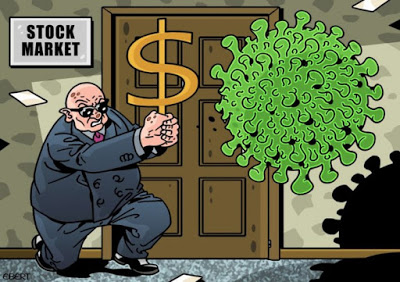The viral crisis in light of the crisis of capitalism
 |
| Manuel Raposo 05/04/2020 |
It would be all too easy for people to attribute the ongoing economic crisis to the coronavirus. The propaganda peddlers already call the market collapse “the COVID-19 crisis.” But, as in chemistry, you have to distinguish between reagents and catalysts. The emergency created by the viral epidemic has only precipitated what was already unfolding and which the most attentive observers had been predicting for at least months.
Tradotto da John Catalinotto
The outbreak of the 2008 global financial crisis was readily attributed to the “greed” of speculators. Now, the finger is pointed at the unanticipated COVID-19. In both cases, what you sense is the attempt to absolve the capitalist system and thus hide the essential causes of this new collapse.
An abrupt but predictable plunge
Recent precipitous stock market plunges demonstrate that the inevitable is already happening: The financial bubble created in the last decade is bursting at the seams, with fictitious capital moved for speculation evaporating at the rate of millions per hour.
The “recovery,” of which there was talk a few months ago, appears to be nonexistent. All the wealth, real or virtual, amassed in the hands of a few, proves to be entirely useless in responding to both the health and the economic crises.
The world’s leading economies, not to mention all of them, are shrinking and entering recession. The International Labor Organization predicts a growth in unemployment of between 5 and 25 million, on top of the almost 200 million already seen (estimated 188 million in 2019 by ILO).
Poverty will hit 9 million more workers. Large companies (such as, in the case of Portugal: TAP, Autoeuropa, PSA or Continental) are closing down or going bankrupt. Thousands of small businesses close their doors to no longer open them.
Twelve years later, none of the evils of 2008 has been solved, and the crash today promises to be even more violent.
A crisis within the crisis
In fact, this is not a second crisis, this one attributed to the virus. It is rather a relapse of the crisis that started in 2008. Faced with the collapse of business, the “solution” then consisted of trying to cover the huge debt of financial institutions by filling their coffers with more fresh money. That is, the “solution” to the debt was to increase the debt — and make the working class pay for it, using austerity measures.


